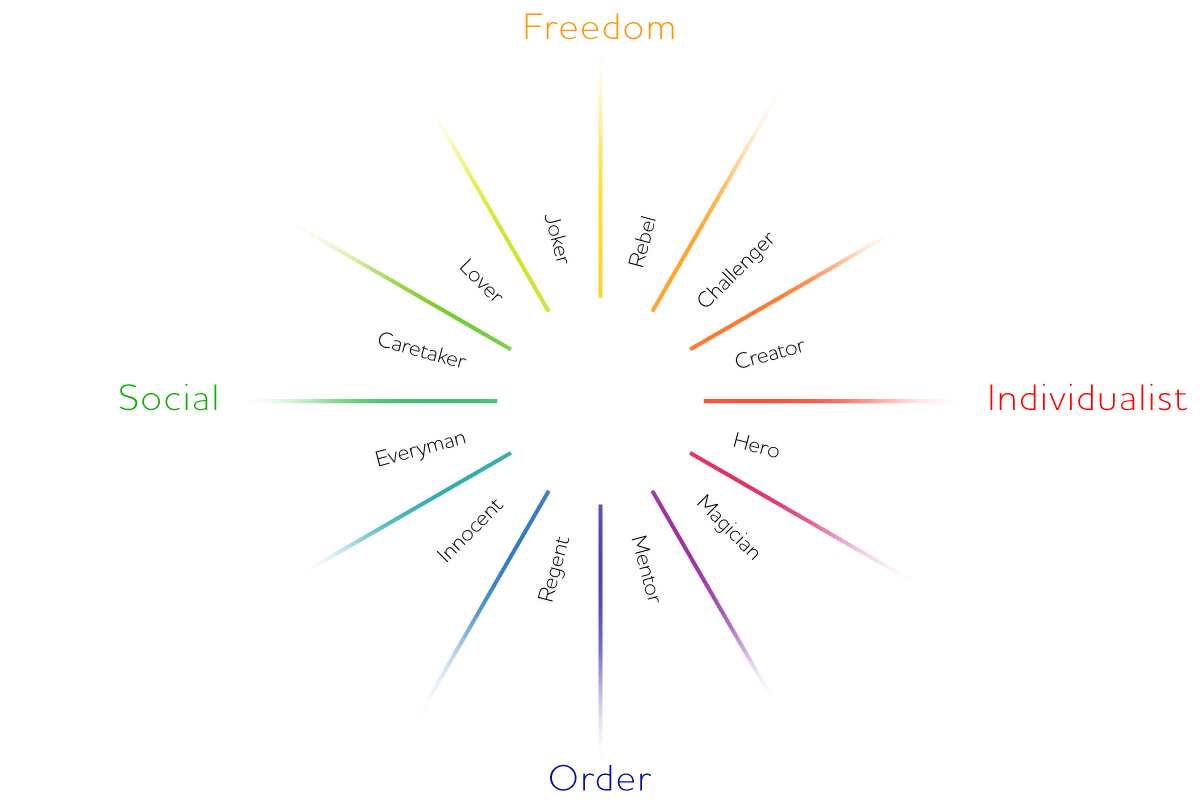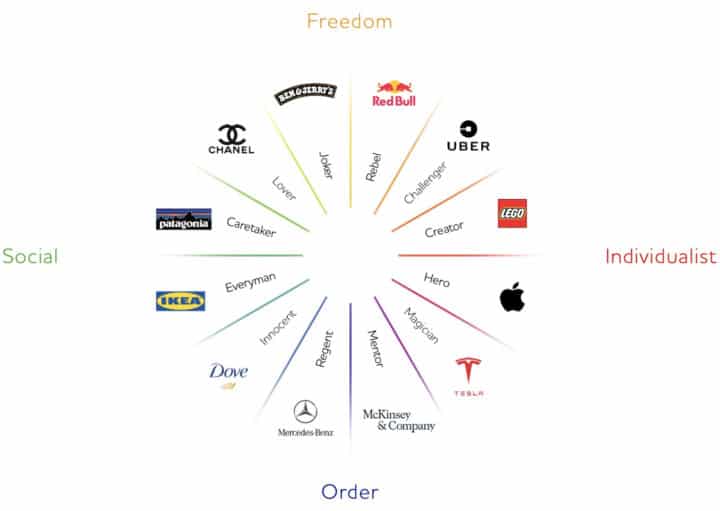

In essence, it is our human brain, that decides what we think of a brand, and how we want to interact with it.
As business leaders evolve, the competition the the markets increases, and markets move faster in every conceivable way, brands must become a liquid, ever-evolving part of this. Defining what type of brand you (or your products) are today, and where you want to go is an essential part of creating a future-proof business.
You may think that you know your brand. Congratulations, you are one of only 25% of employees / leaders worldwide that truly does. Knowing your brand means knowing what your key audiences, stakeholders, and in the end, customers think of it. And why they think that way about it.
The starting point of any archetype exploration is to place your brand on the archetype wheel – based on how you are perceived today by your most important audiences.
This usually requires insight based on analysis or stakeholder audits. And don’t forget to consult with the employees – remember the 25 percent, and the other 75! You might be surprised by the answer you get. Maybe your brand wasn’t perceived quite as you thought.
Which archetype you want to be perceived as has implications and sets guidelines for how the business should be run, how the brand needs to act, and what strategic decisions need to be made to make this work.
The brand archetypes help companies articulate their purpose and translate that effort into aspirational milestones and actionable transformations.
Think about it – moving from a “challenger” to a “hero” demands a completely new set of principles, a new direction, and certainly new way of leading the brand. Maybe the visual brand identity needs an update? Perhaps the branding strategy needs to be reworked. Even the product may have to be evolved, perhaps even discontinued, to match this new direction.
By specifying and developing your archetype, you work towards influencing the audience and stakeholders’ perception of the brand – which facilitates growth, new verticals, and a new position.
The archetypes can be used to articulate and define what kind of brand we can be, and are designed to match the different ways humans can be differentiated, in terms of both character, association and focus.
This means that we can easily understand and place brands on the archetype wheel – they simply represent all of humanity, which has been around us for a few decades.
Four areas of belonging:
In the same way as people’s personalities, the brand archetypes can be grouped into four general areas:
Twelve brand archetypes:
Distributed across these groups fours are 12 brand archetypes.
Note this – a circle has no edges, and neither do the archetypes. Brands flow freely between the archetypes, and it is not unusual to see a brand grow from one archetype to another. Even from one parent group to another.

A rebel breaks the rules and never takes no for an answer. It deliberately makes choices that are different (sometimes on the very edge of society and what is considered acceptable) and breaks away from tradition in almost everything it does.
Example Rebels are Red Bull, Kahoot and Harley Davidson
Challenger brands are close to the rebels but are more focused on challenging processes, products, and how people usually do things. They create an alternative universe – often better, more efficient, and more intuitive than what we are used to. Therefore, they often challenge legislation and general regulations.
Ah, the inspiring and innovative problem solver. Creators use existing assets, thoughts, and problems and turn them into opportunities. With extreme creativity, they are visionary and very passionate about their mission of creating better solutions to known problems and processes. They do not necessarily challenge existing solutions directly, but often turns into a fierce competitor by creating better solutions
, Pixar
Everybody wants to be a hero. Having moved on from being a challenger, creator, or magician, the hero brands are the undisputed leaders of the space in which they rule. By challenging new markets through constantly creating new verticals, they are risk-taking winners.
While the Hero brands often lead the market they are in, the Magician brands often transform and define the market. Changemakers at the core, they are never “too big to fail” and are willing to take on even more risks on their mission to change the status quo. Through constant, creative, and successful innovation. Leaving their audience mesmerized by possibilities, they create a strong following and loyalty from fascinated customers.
Example Mentors are United Nations, McKinsey & Company, and Deutsche Bank.
A regent is the administrating leader. The brands are very close to mentors in many ways, especially when it comes to leadership, but they are less focused on the educational aspect. They are often leading their industry by size and competence, and they are predictable, trusted brands that often go back a few decades.
Example Regents are Mercedes Benz and Formula One
The Everyperson is there for everyone. They are interested in all of humanity and therefor offer products and services that are accessible, diverse, and often high value for money. These brands will usually have a wide range of products that fit a large and broad market, and usually own large parts of the value chain.
This is the protective and selfless fighter. The caretaker brands see it as their mission to fight for a better world. They look after those weaker than themselves, even when it means sacrificing their own well-being. Very focused on sustainability, ethics, and an overall positive footprint, caretakers will put customers, humanity, and the planet before profit, quality over quality, and impact over intentions. These are the brands that “walk the talk” – they keep their promise
The lovers are magnetic. These brands are caring, passionate and dreamy. Sometimes even idealistic but could also be highly commercial triggering warm and good emotions. Usually you will find communication and products to be built around a specific emotion, like happiness or desire, what will make the audience feel better.
Joker brands are fun and spirited – a jester! They tend to surprise and polarize, and with that, win over the audience. Therefore they usually lead their market – not necessarily by size, but by recognition. These brands are entertaining for sure, but what they really bring to the table are ideas, innovation, and the ability to reframe concepts as no other can. At peace with the paradoxes of the world, the Joker can use humor to emphasize social issues — and point out how silly these are.
“We need a new narrative” is not uncommon to hear in executive meetings. It’s no longer enough to say “we make great shoes”.
Read the storyRebranding is a powerful strategic tool to reposition a firm, or manifest a new direction. This is a perspective on the do’s and dont’s, and what to consider before you inform your board.
Read the story